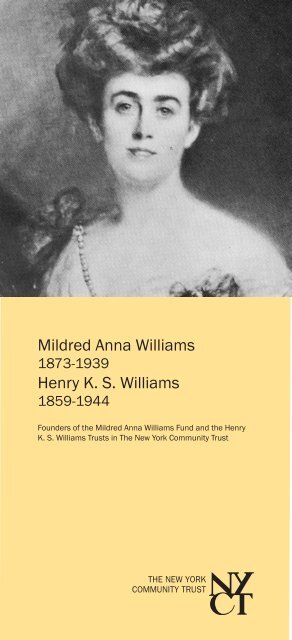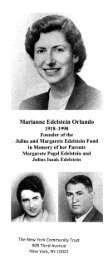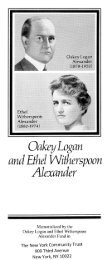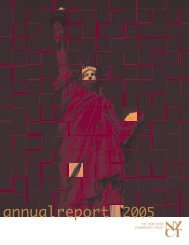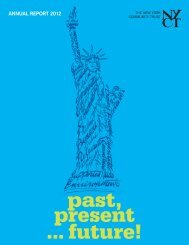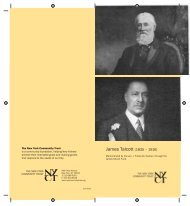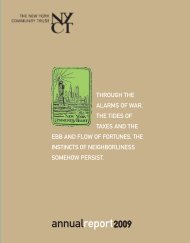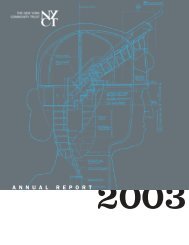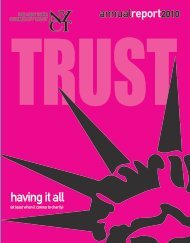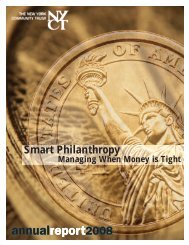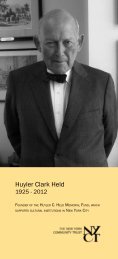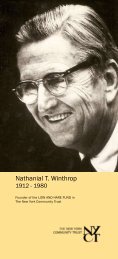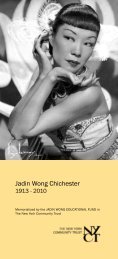Mildred Anna Williams Henry K. S. Williams - The New York ...
Mildred Anna Williams Henry K. S. Williams - The New York ...
Mildred Anna Williams Henry K. S. Williams - The New York ...
You also want an ePaper? Increase the reach of your titles
YUMPU automatically turns print PDFs into web optimized ePapers that Google loves.
<strong>Mildred</strong> <strong>Anna</strong> <strong>Williams</strong><br />
1873-1939<br />
<strong>Henry</strong> K. S. <strong>Williams</strong><br />
1859-1944<br />
Founders of the <strong>Mildred</strong> <strong>Anna</strong> <strong>Williams</strong> Fund and the <strong>Henry</strong><br />
K. S. <strong>Williams</strong> Trusts in <strong>The</strong> <strong>New</strong> <strong>York</strong> Community Trust
<strong>The</strong> stately marble entrance of a city library,<br />
fine woodwork inside historic Pullman<br />
train cars, a superb collection of paintings,<br />
and a handsome courthouse. <strong>The</strong>y may seem<br />
unrelated, but are through <strong>Henry</strong> Knapp Skelding<br />
<strong>Williams</strong>, whose businesses included fine<br />
hardwoods and marble and whose avocation was<br />
collecting art.<br />
<strong>The</strong> son of Ichabod Thomas and Elizabeth<br />
Hannah Skelding <strong>Williams</strong>, <strong>Henry</strong> came from a<br />
<strong>New</strong> <strong>York</strong> family descended from the Pilgrims. After<br />
graduating from St. John’s Preparatory School in<br />
Ossining, <strong>New</strong> <strong>York</strong> in 1875, he entered his father’s<br />
wholesale lumber business, Ichabod T. <strong>Williams</strong> &<br />
Sons. His work for the firm took him through the<br />
forests of Ohio, Indiana, Michigan, and Canada.<br />
He became an expert on domestic hardwoods<br />
and then branched out all over the world in search<br />
of special quality lumber—to South and Central<br />
America, Africa, and as far as the Andaman Islands<br />
in the Indian Ocean. He spent ten winters in Cuba,<br />
and one in the Dominican Republic.<br />
He was known as an enterprising buyer who<br />
did not hesitate to purchase daringly large quantities<br />
of rare woods when he anticipated a new<br />
market for them. He introduced padouk, a hardy<br />
reddish wood from Burma, into widespread use in<br />
the States by interesting the railroads in using it<br />
for the interior of Pullman passenger cars. He also<br />
is believed to have been the first to sell American<br />
hardwoods to Europe. During World War I, he was
<strong>Henry</strong> K. S. <strong>Williams</strong><br />
a dollar-a-year man—working for a token salary for<br />
the War Department purchasing large quantities<br />
of hardwood that could be made into airplane<br />
propellers.<br />
In 1912 he became president of William<br />
Bradley & Sons, a firm that supplied marble for<br />
many public buildings across the U.S.—including<br />
Chicago’s City Hall, the St. Louis Library, Albany’s<br />
Educational Building, the Memphis Courthouse,<br />
the interior of the <strong>New</strong> <strong>York</strong> Public Library as well<br />
as much of Grand Central Terminal. He was also<br />
president of White Rock Mineral Spring Company,<br />
the Otis Astoria Corporation, and the George D.<br />
Emery Company.<br />
<strong>The</strong>se responsibilities might have been<br />
enough for some executives, but Mr. <strong>Williams</strong><br />
somehow found time for other tasks. Because<br />
of his reputation for integrity, he was frequently<br />
appointed by the courts as receiver of bankrupt
concerns. And in 1919, because of his interest in<br />
the welfare of his native city, he was asked by the<br />
City police commissioner to develop a plan to help<br />
<strong>New</strong> <strong>York</strong> police officers deal with the rising cost of<br />
living. He was made an honorary deputy chief and<br />
proceeded to organize a home service division.<br />
With a revolving loan from the Police Benevolent<br />
Fund, it set up stores in all five boroughs stocked<br />
with shoes, clothing, and groceries that policemen<br />
could buy at cost.<br />
<strong>Williams</strong>’s first wife died in 1912, a year after<br />
he retired from his family’s lumber firm. A few years<br />
later, he met <strong>Mildred</strong> <strong>Anna</strong> Milton, with whom he<br />
shared the second half of his life.<br />
<strong>The</strong> second Mrs. <strong>Williams</strong> was the daughter<br />
of John McQuillan, a marine engineer from Vallejo,<br />
California. Her childhood had not been easy and<br />
she supported herself before her first marriage—a<br />
fact that was later reflected in her compassion<br />
for needy young girls. A beautiful and vivacious<br />
woman, and then a widow, she met Mr. <strong>Williams</strong><br />
literally by accident; her automobile broke down<br />
on a country road and Mr. <strong>Williams</strong> stopped to<br />
help her.<br />
Soon after the end of World War I, Mr. and<br />
Mrs. <strong>Williams</strong> went to live in France. <strong>The</strong>y collected<br />
17th century Dutch and Flemish paintings, 18th<br />
century English masters, bronzes, tapestries, statuary,<br />
and period furniture. <strong>The</strong>y never considered<br />
themselves collectors; they simply bought what<br />
they enjoyed having in their homes. Neither of<br />
them was artistically gifted, but they appreciated<br />
fine craftsmanship. Mr. <strong>Williams</strong> may have become<br />
interested in art through his wife and through the<br />
famed millionaire and art collector <strong>Henry</strong> Clay Frick,<br />
who was a friend of hers.<br />
<strong>The</strong> <strong>Williams</strong>es loved to travel, going around<br />
the world twice, across the country innumerable<br />
times, and even touring North Africa by car. During
“Never say you are grateful. That<br />
always implies an expectation of<br />
further favors.”<br />
– <strong>Henry</strong> K. S. <strong>Williams</strong><br />
these trips, they bought more art and furniture for<br />
their homes and soon had a fine, though somewhat<br />
unintentional, collection. It was an old friend, Mrs.<br />
Adolph Spreckels of San Francisco, who persuaded<br />
them to deed their art to the California Palace of<br />
the Legion of Honor, a museum she had founded<br />
in San Francisco. <strong>The</strong>y did this in 1929, with a<br />
proviso that the collection would remain in their<br />
Paris home until their deaths.<br />
Mrs. <strong>Williams</strong> died just before World War II<br />
and, at Mr. <strong>Williams</strong>’s urging, the museum managed<br />
to have the collection hastily packed, spirited<br />
to Marseilles, and put aboard an American vessel<br />
only a few weeks before Paris fell to the Germans.<br />
<strong>The</strong> paintings, tapestries, and furniture were then<br />
installed in the California Palace as the <strong>Mildred</strong><br />
<strong>Anna</strong> <strong>Williams</strong> Collection. Today the collection<br />
includes more than 100 paintings.<br />
In Mr. <strong>Williams</strong>’s later years, the museum became<br />
his main interest. He stayed in San Francisco<br />
six months of the year and visited the museum<br />
several days a week, occasionally making suggestions<br />
about weeding out pictures that were not of<br />
top quality. He would also surprise the museum<br />
with new purchases at least twice a year. <strong>The</strong> curator,<br />
Thomas Howe, never knew ahead of time what<br />
masterpiece Mr. <strong>Williams</strong> had succumbed to; he
“After the Hunt,” 1885<br />
by William Michael Harnett<br />
<strong>Mildred</strong> <strong>Anna</strong> <strong>Williams</strong> Collection<br />
Fine Arts Museums of San Francisco<br />
simply received a welcome letter announcing that<br />
“I have ‘fallen’ again.”<br />
Mr. Howe remembered Mr. <strong>Williams</strong> as a<br />
marvelous friend, a genial and witty bon vivant<br />
who was invariably kind and modest. He recalls<br />
that once he said to Mr. <strong>Williams</strong>: “I can’t begin<br />
to tell you how grateful we are for…” Mr. <strong>Williams</strong><br />
interrupted with the admonition: “Never say you<br />
are grateful. That always implies an expectation<br />
of further favors.”<br />
Mr. Howe also recollected that one of the<br />
finest pieces of Americana in the <strong>Williams</strong>’s collection<br />
was acquired somewhat accidentally. While<br />
in <strong>New</strong> <strong>York</strong> in 1940, Mr. <strong>Williams</strong> had dropped in<br />
to see his old friend Charles Henschel, the head<br />
of the Knoedler Galleries. While waiting to talk to<br />
Mr. Henschel he saw a large still life propped on<br />
an easel and asked the secretary, “What is that<br />
painting?”<br />
“Oh, that’s nothing for you,” she replied.<br />
“It’s just a picture that Mr. Henschel thought<br />
might amuse Mr. Averell Harriman for his hunting<br />
lodge.”<br />
Perhaps somewhat nettled, Mr. <strong>Williams</strong><br />
asked how much it was.<br />
“Ten thousand dollars.”<br />
He responded, “Have it shipped to the California<br />
Palace of the Legion of Honor.” And that is<br />
how the Legion came to acquire William Harnett’s<br />
valuable trompe l’oeil “After the Hunt.”
While they enjoyed their art and lived a gracious<br />
life, the <strong>Williams</strong>es were very conscious of<br />
those less fortunate. <strong>The</strong> funds and trusts they<br />
established in <strong>The</strong> <strong>New</strong> <strong>York</strong> Community Trust<br />
stand as a symbols of their generosity, empathy,<br />
and understanding.<br />
<strong>The</strong> will of Mrs. <strong>Williams</strong> established the <strong>Mildred</strong><br />
<strong>Anna</strong> <strong>Williams</strong> Fund in <strong>The</strong> <strong>New</strong> <strong>York</strong> Community<br />
Trust, to help girls and young women. Mr. <strong>Williams</strong><br />
left two funds, one for the benefit of St. Mary’s<br />
Hospital in Queens for chronically ill children.
<strong>The</strong> <strong>New</strong> <strong>York</strong> Community Trust<br />
is a community foundation, helping <strong>New</strong> <strong>York</strong>ers<br />
achieve their charitable goals and making grants that<br />
respond to the needs of our City.<br />
909 Third Avenue<br />
<strong>New</strong> <strong>York</strong>, NY 10022<br />
T: 212-686-0010<br />
F: 212-532-8528<br />
www.nycommunitytrust.org<br />
April 2009


